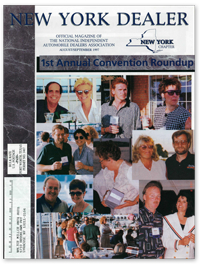
New York Auto Dealer 1997
A Time Machine of the Automobile Age
|
|
|||
|
NIW YORK DEALER
|
|||
|
|
|||
|
OFFICIAL MAGAZINE OF
THE NATIONAL INDEPENDENT
AUTOMOBILE DEALERS ASSOCIATION
AUGUST/SEPTEMBER 1997
|
 |
||
|
|
|||
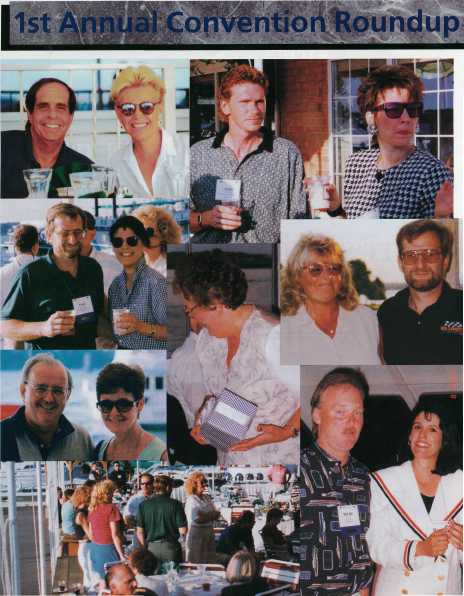 |
|||
|
|
||||
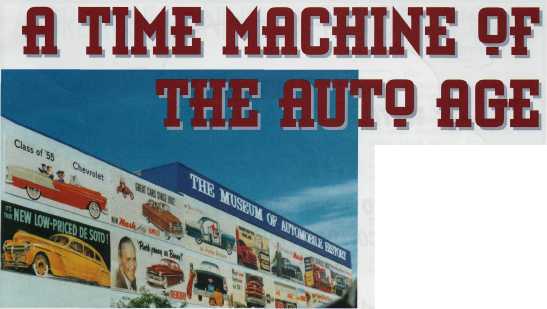
Hundreds Of Years –
Of Memories
|
||||
|
|
||||
|
I
f just one museum could reflect all that the car has meant for the last two-hundred years, it would be the new Museum of Automobile History in Syracuse, New York. Including the largest private collection of automobilia in the world, the museum is literally a "memory lane" for every generation which has grown up along with the car itself in the 20th century. The museum takes visitors through over two-hundred years of the Automobile Age, with over ten-thousand items pertaining to well over one-thousand makes of automobiles, motorcycles, and trucks. It evokes the work that the automobile left in its wake, in extensive displays of advertising, posters, toys, models, design drawings, fine art, folk art, and more.
|
painting — as interested in a DeSoto billboard, twenty-feet wide, as he was in a model sports-car, hand carved in wood, the history of the automobile is in all of it.
"There isn’t a person living in America today whose life wasn’t influenced or shaped by the automobile," says Walter Miller. Amassing the collection combined his business experience, as the leading dealer in automobile literature in the world, and his academic training as a historian. By the time he was ready to put part of his collection on public display, it required 12,000 square feet, in rooms with 25-foot ceilings.
On the outside, The Museum of Automobile History literally stops traffic. The exterior is lined with twenty authentic full color billboards — each measuring twenty feet by ten feet — advertising America’s favorite family cars of the 1940s and 1950s. Passersby do a double-take, because many of
|
the makes advertised aren’t even for sale anymore. It’s no dealership, but the biggest
continued on page 14
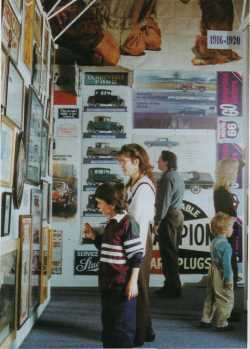 |
||
|
"There isn’t a person living in America today whose life wasn’t influenced or shaped by the automobile."
|
||||
|
The Museum of Automobile History, the first institution to trace the social effect of the century’s favorite machine, grew out of the lifelong collection of Walter Miller. For over thirty years, he roamed flea markets and fine antique shops around the world, looking for items that connected people to cars. Miller would be just as interested in an old family photo of two kids playing in a track as he was in a rare automobile oil
|
||||
|
|
||||
|
|
||||
|
A Time Machine of the Auto Age
continued from page 7
collection displayed anywhere of authentic, original colorful and memorable automobile billboards.
Inside, the space is modem and well-lit, designed for the new museum by noted Syracuse architect Robert Levy. Visitors can look for items related to their favorite cars, or follow a chronological route through the running display of memorabilia. It starts with original newspaper accounts of the inventions that preceded the automobile, and proceeds to touch on every type of car created ever since. In fact, one of the rare items on display is the autograph of Charles Duryea, the man credited with building America’s first production automobile in 1896.
Among the other items seen on display are: movie posters from car-crazy Hollywood pictures; fine oil paintings and drawings by serious American and European artists; design models used by Detroit stylists, war posters from around the world, showing cars in battle; letters from auto designers and executives, including Henry Ford II, Ransom Olds, Raymond Loewy, E.L. Cord, Ferry Porsche and Walter Chrysler; racing items and memorabilia; thousands of toys, games and children’s books that helped to raise kids in a car world; rare auto accessories and gadgets; humorous items and cartoons plus thousands of other
|
large screen, set on the back of a miniature truck. Visitors can opt to sit for a while, to watch the Auto Age in action. A special section of the museum highlights posters and memorabilia from some of the Hollywood movies to glamorize the car. And if visitors want to start their own
|
European and American artists.
Nearly anyone who visits The Museum of Automobile History will see a car or an ad or a picture that reminds them of their own bit of automobile history. Taken altogether, though, the experience is more than that. Miller worked closely with curator
|
||
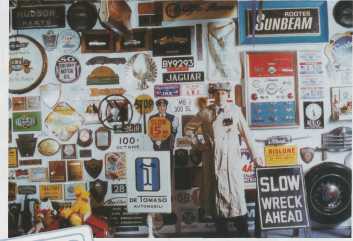 |
||||
|
|
||||
|
items—as you walk through a time machine of the Automobile Age.
Model T Fords, Chevrolets, Jaguars, Duesenbergs, Harley-Davidsons, Dodges, Volkswagens, Porsches, Toyotas, Packards, Lincolns, Indians, Stutzes and Jeeps — they’re all part of The Museum of Automobile History.
Cars are even in the air: visitors touring the galleries hear original radio advertisements and musical jingles for great cars. With hundreds of hours of recordings available, visitors aren’t likely to hear a repeat. The museum is also on the move with video. Race footage, vintage television-ads and historical documentaries run on a
|
collection of auto memorabilia, the gift shop sells new & old car magazines, books, posters, toys, and brochures, as well as souvenirs of the museum. "The main focus," says Miller, "is that there is no focus. Most collectors are into one aspect or another of the automobile — mascots, for instance, or a particular type of car like the Packard. My eye has taken in anything related to the car. That’s the effect that I want."
The feeling of taking a walk through the Auto Age continues in the second main room of The Museum of Automobile History; its cases are filled with objects ranging from Flintstone and Batman toy cars to rate large-scale Detroit automobile design-models, from unique radiator caps to cars made to scale in wicker, clay, wood, tin or cloth. The museum’s fine art collection, concentrated on the walls surrounding the cases, includes over one thousand paintings and pencil sketches, many by renowned
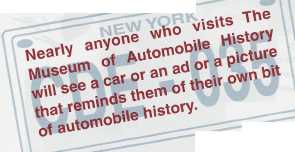 |
Elisa Deyneka to organize the many thousands of items into a total effect that is even greater than the sum of those many parts.
"Technology is moving so fast that people under thirty don’t know a world without computers," Miller says. "People under fifty don’t know one without television. Almost no one living today remembers the world without automobiles. Unless you live without something, you take it for granted. People of any age can emerge from The Museum of Automobile History with an understanding of why the auto has been the single most important invention of our time, or of all time," Miller explains.
Automobiles themselves, while they are beautiful to look at, don’t mirror the people who used them, sold them, made them, loved them and even hated them, as vividly as the unexpected items left behind by those people. Walking through The Museum of Automobile History, a visitor can discover just how our whole nation—our whole planet—took to wheels in this century.
|
||
|
|
||||


